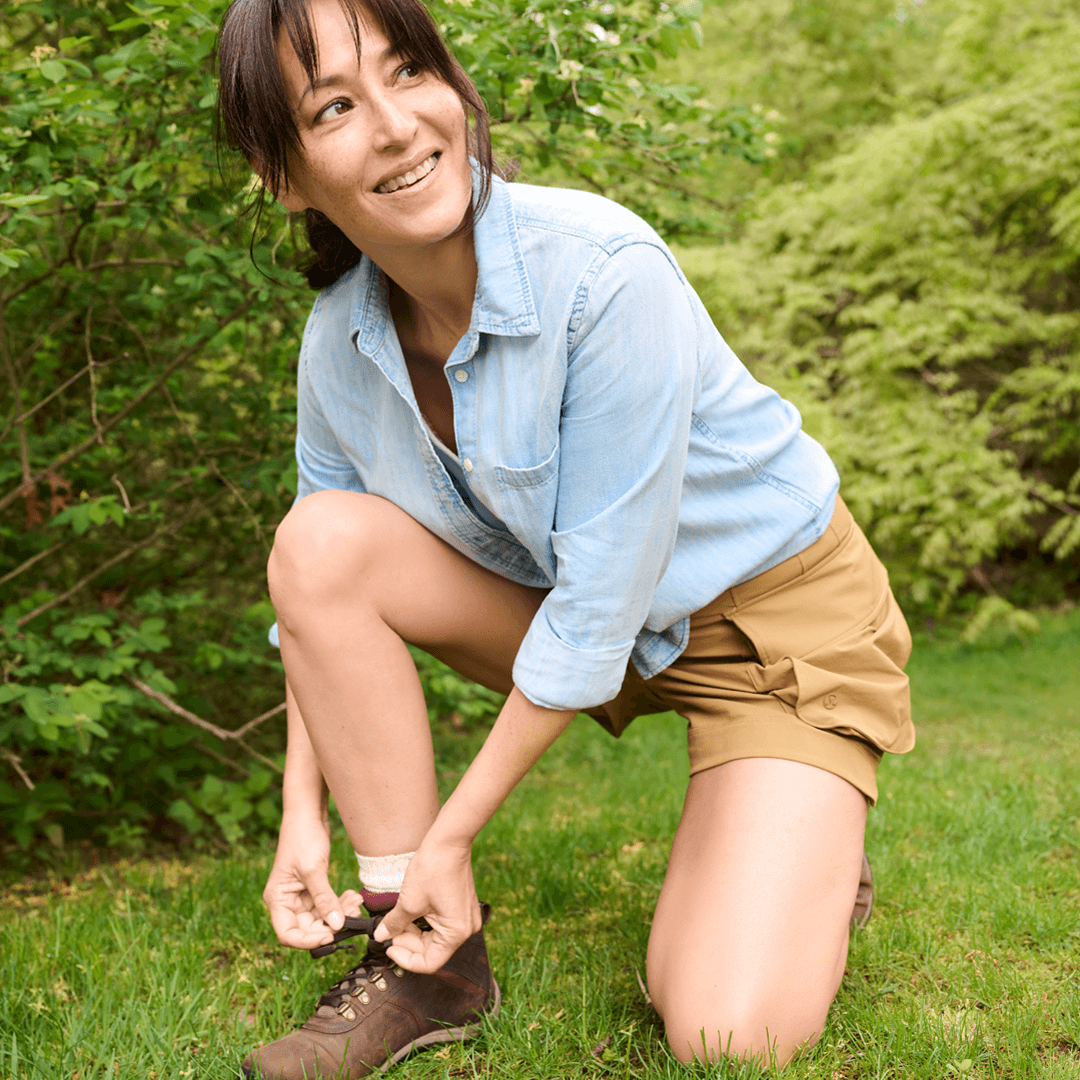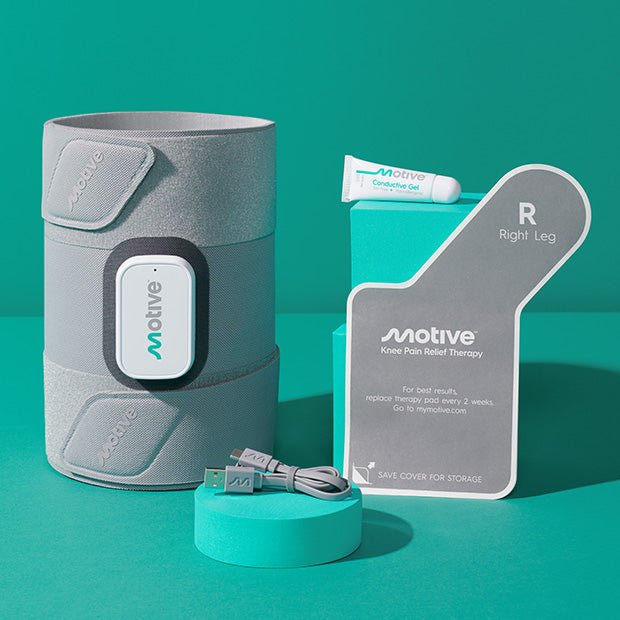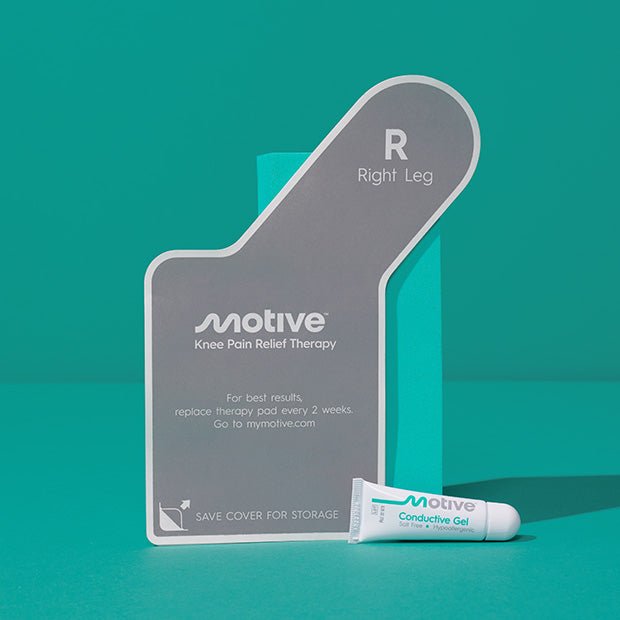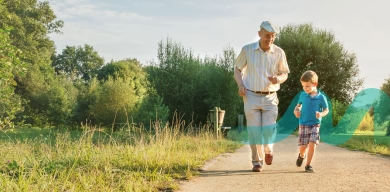
When we experience pain in our knees it hinders our muscle activation, resulting in an ongoing cycle of pain, muscle weakness, and decreased function. If you want to decrease your pain and increase your knee function, it's important to keep track of the health and stability of your knee. Strengthening your quadriceps muscles is critical when maintaining healthy knees, and can help with issues such as:
- knee stiffness
- knee swelling
- creaking knees
- popping or crunching in the knees
- inability to straighten the knee
- knee tightness
Due to limited range of motion and the weight it carries, the knee joint is more prone to injury and overuse. Since your knee ligaments, cartilage, and meniscus all endure the burden of the stress from daily use, building stability is of utmost importance.
Understanding the Anatomy of Your Knee Pain
The knee can be considered an "innocent bystander" between the hip and the foot, as pain experienced in the knee is often a result of issues happening either above or below it. Since the knee is the largest joint in the human body, it's crucial to maintain well-balanced and strong muscles to avoid exerting excessive stress.
Your knee is comprised of static and dynamic stabilizers:
- Static stabilizers are your bones and ligaments (ACL, PCL, MCL, LCL).
- Dynamic stabilizers are your muscles, which connect to bones via tendons (quadriceps femoris and extensor retinaculum)
The stability of your knee joint depends on several factors:
- The position of the knee and surrounding joints
- The direction and strength of the force being applied to your knee joint
- The strength and function of your muscles and ligaments that support your knee joint
- Structures to support the knee if primary restraints fail to work properly
Common Causes of Knee Pain
Knee pain is most commonly caused by overuse injuries, arthritis, and traumatic injuries. It does not discriminate when it comes to age; knee pain affects all ages, and the intensity can range from minor to excruciating pain.
Arthritis
Arthritis is a medical condition that can affect numerous joints throughout your body. If arthritis develops in your knee, it results in joint inflammation, which can cause significant discomfort.
Osteoarthritis
Osteoarthritis, commonly known as degenerative joint disease, is the most common form of arthritis. This condition occurs when wear and tear breaks down the cartilage within a joint. This degradation of the cushioning causes the bones to rub against each other, can change bone shape, and lead to chronic joint inflammation, pain, and stiffness. In certain cases, it can decrease mobility and may even cause disability. Although the signs and symptoms of osteoarthritis are more prevalent in people over the age of 50, it can affect younger individuals as well, especially if the person has had a joint injury in the past.
In addition to age, women and overweight individuals have an increased risk of developing this condition. Individuals with repetitive stress injuries or overuse due to work or athletics also have an increased risk of developing osteoarthritis of the knee.
Rheumatoid Arthritis
Rheumatoid arthritis is a chronic inflammatory and autoimmune disease that mainly attacks the joints but can also affect a variety of other body systems. With an autoimmune disease such as rheumatoid arthritis, the immune system mistakenly attacks the body's own cells. The synovium (lining of a joint) becomes inflamed, resulting in painful swelling. In turn, the joint tissue becomes damaged, potentially causing chronic pain, unsteadiness, and even bone erosion and joint deformity. This disease usually affects the same joint on both sides of the body, as in both knees or both ankles.
Overuse
Repetitive knee activity can lead to pain, a few examples include the following:
Patellofemoral Pain Syndrome (Runner's Knee)
Patellofemoral pain syndrome is a general term used when describing pain at the front of the knee, around the patella (kneecap). It is commonly known as "runner's knee" due to its prevalence among those who participate in sports, although nonathletes may also experience this sort of pain. Patellofemoral pain syndrome can be linked to a variety of causes, including overuse or repeated stress, muscle imbalances or weaknesses, trauma to the kneecap, and knee surgery. The dull, aching pain may be exacerbated by climbing up or down a flight of stairs, kneeling, squatting, or sitting with a bent knee for a long period of time. Resting and icing the area may help to ease the pain, but certain cases may require physical therapy.
Patellar Tendinitis (Jumper's Knee)
"Jumper's knee", or patellar tendinitis, is a condition where the patellar tendon becomes irritated or inflamed, usually attributed to overuse. The patellar tendon connects the bottom of the kneecap to the top of the shinbone, and, along with the muscles at the front of the thigh, is what helps extend the knee so that one can run, jump, and kick. As alluded to by its nickname "jumper's knee", this condition is very common among athletes involved with sports where frequent jumping or sprinting is required, such as basketball, football, gymnastics, or volleyball.
Injury
Damage and abrupt impact can harm various parts of your knee joint, with common injuries including:
Knee Bursitis
Knee (or patellar) bursitis occurs when the small fluid-filled sac (called a bursa) located by the knee joint becomes inflamed. The bursa in front of the patella becomes irritated and produces excess fluid, causing it to swell and add pressure to surrounding areas of the knee. Workers who are constantly kneeling, such as plumbers, gardeners, and carpet layers are prone to knee bursitis, as well as athletes who participate in sports that result in direct blows or falls on the knee, like football, volleyball, or wrestling.
ACL Injury
An anterior cruciate ligament (ACL) injury is a very common knee injury which occurs in over 200,000 people each year. The ACL runs diagonally in the middle of the knee, connecting the femur (thighbone) and the tibia (shinbone) to help stabilize the knee joint. An ACL injury occurs when the ligament is damaged, resulting in either a partial or complete tearing of the tissue. ACL injuries often occur during fitness activities when a person changes direction rapidly, stops suddenly, lands incorrectly from a jump, or through a collision or direct blow to the knee. Depending on the grade on the severity scale, treatment can range from rest and rehabilitation exercises to surgery followed by rehabilitation.
Torn Meniscus
A meniscus tear occurs when a piece of cartilage located between the thighbone (femur) and shinbone (tibia) becomes injured and tears (commonly classified into a bucket handle, flap, or radial tear). This common knee injury typically results from a forceful twisting or rotating of the knee when supporting full body weight. The meniscus can also tear as a result of degenerative changes as one ages. A torn meniscus may cause pain, stiffness, and swelling. In certain cases where a piece of cartilage breaks loose and gets caught within the knee joint, the knee can lock and inhibit full extension.
Managing & Treating Knee Pain
Since your quadriceps muscles are the POWERHOUSE of the knee, it is critical to maintain muscle strength to support the joint and manage knee pain.
You can better manage and decrease your knee pain by activating the dynamic stabilizers (muscles) around the knee. For mild knee injuries and less severe knee pain, there are exercises that can aid in easing the pain, along with maintaining knee stability.
Some effective exercises you can add to your routine to relieve knee pain include:
- Squats
- Straight leg raises/lifts
- Inner thigh stretches
- Standing hamstring curls
- Standing knee lifts
Electrical Stimulation – TENS and NMES
Another way to manage knee pain is through electrical stimulation. Electrical stimulation (e-stim) is a type of physical therapy modality or treatment used to accomplish various tasks in physical therapy (PT) or at home.
E-stim is a popular therapy due to its major benefits including:
- Improving weak muscles
- Strengthening muscles that are not functioning correctly
- Decreases pain and spasms
Transcutaneous Electrical Nerve Stimulation (TENS): TENS devices target the sensory nerves, which are responsible for sending pain signals to the brain. This therapy can temporarily relieve pain while the device is in use. However, is it not a long-term solution to treat pain.
Neuromuscular electrical stimulation (NMES): NMES therapy involves using a device that applies electrical currents to motor nerves in the muscles, causing the targeted muscles to contract. This stimulation can help strengthen and maintain muscle strength, increase range of motion, and prevent atrophy.
Proper recruitment, activation, and strengthening of your quadriceps muscle group will ultimately assist in lifting weight off the knee joint and support it during functional tasks. Of course, more serious knee injuries and conditions may require invasive treatment or surgery for ligament tears and damaged tendons.




